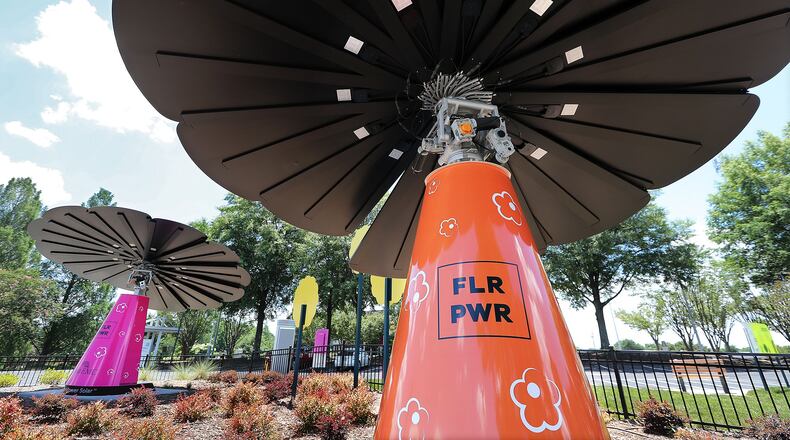When neighbors inquire about the solar panels on the roof of his home in the city of Decatur, Gary Garrett is eager to share all the details.
“Once COVID-19 is over, I’ll pull out my phone and show them the app,” he said referring to the program that displays the amount of solar energy his home generates and consumes in 15-minute intervals.
Garrett, an energy policy retiree, and his wife who serves as Decatur’s mayor, were early participants in Solarize Decatur, a program that uses group buying power to help reduce the cost of solar installations. The couple anticipates the energy output will meet 60 to 65% of their needs. “We have wanted to do something environmental in a bigger way for our home for a while,” Garrett said. “This was an opportunity to reduce our carbon footprint ... and have free fuel costs for the foreseeable future.”
Solar installations have sprung up across the metro area this spring. In addition to the second round of residential solar in the city of Decatur and DeKalb County, Cobb EMC added three 18-foot tall sunflower-shaped solar panels to its larger solar project, and Emory University partnered with Cherry Street Energy to install 15,000 solar panels across 16 buildings on its campus.
Georgia often ranks among states with the highest electricity costs in national consumer surveys. Meanwhile, the price of solar has dropped dramatically over the past decade from more than $8 per watt in 2009 to under $3 per watt in 2019, according to EnergySage, a service that pairs homeowners with solar installers.
>>RELATED: Georgia commissioners increase solar power, cut coal
Though larger utility-scale solar projects have the biggest impact on renewable energy, smaller-scale efforts also play an important role, said industry experts. Michael Chanin, CEO of Cherry Street Energy said solar energy allows people to become their own power providers and increases awareness of energy consumption.
Through the Solarize Decatur program, about 234 homeowners have requested evaluations and more than 20 contracts have been signed, representatives said.
Without group buying, an average sized system with 15 panels for a 2,000 square foot home would offset 50% of the utility bill and would cost about $15,000. If Solarize reaches its goal, participants would save about 30% of that cost in addition to benefiting from federal tax incentives.
Credit: Curtis Compton
Credit: Curtis Compton
Homeowners also benefit from Georgia Power’s recent shift to higher compensation rates for unused solar energy that goes back to the grid. The program is limited to the first 5,000 residential customers who join.
Only about 8 percent of Georgia’s electricity generation comes from renewable resources, but a November survey from the Yale Program of Climate Change and Communication found that nearly 64% of Georgians think developing more renewable energy sources, such as wind and solar, should be the most important priority for addressing Georgia’s energy needs.
Regulatory modifications in 2015 that allow private investors to install, own and maintain solar panels on behalf of homeowners and businesses enabled Emory University to move forward with plans for a larger solar installation.
>>RELATED: Georgia universities offer lessons in clean energy
Cherry Street Energy will install 15,000 panels on rooftops and parking decks across the campus to generate about 10 percent of the University’s peak energy use. Under the 20-year agreement, Emory does not incur any upfront costs and buys the power at lower rates than the utility charges.
The effort will help propel the institution closer to its goal of 100% clean energy by 2035, said Ciannat Howett, associate vice president of resilience, sustainability and economic inclusion for Emory University. “We went from solar on a few of our buildings to one of the largest installations on a campus in the southeast,” she said. “We have moved into becoming an energy generator.”
>> RELATED: Sun gets second job at Georgia vineyard: powering winery
Several buildings, including hospitals and health sciences, will be on a micro-grid so they won’t lose power in the event of an outage, Howett said. The installation also provides training for students to both learn about solar energy and view it as an energy source for the future, she said.
Education was also an important aspect of the Solar Garden on the corporate campus of Cobb EMC. The giant sunflower-shaped solar panels can be seen from Highway 41 putting the latest solar technology on display for the community.
“The Solar Garden and Smartflowers are reflections of our sustainability efforts to provide clean, reliable, power to our co-op members while educating the community about the importance of solar energy,” said Peter Heintzelman, President and CEO of Cobb EMC.
Open from dusk to dawn, the 6,000-square-foot garden features educational signs and is open for learning events. Like flowers in a garden, the petals of the “smartflowers” open each morning and rotate to follow the sun and maximize solar output.
The three flowers on the campus, part of a larger solar and battery project at Cobb EMC, produce enough energy to charge 3,705 smartphones for a year and will ultimately help Cobb EMC operate at near zero-carbon energy.
About the Author
Keep Reading
The Latest
Featured





